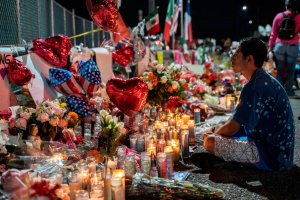
El-Paso Memorial for the victims of the mass shooting that took place on 3 August 2019. Image Credit: Paul Ratje of Agence France-Presse (Getty Images)
Infamously coined ‘lone-wolf’ attacks or acts of violence, the United States has tragically experienced 2 separate mass shooting occurrences this month that claimed the lives of many innocents. The shooting in El-Paso, Texas, carried out by 21-year-old Patrick Wood Crusius, is being treated by United States Federal Prosecutors as “domestic terrorism”. Federal officials, however, have been hesitant to use the term “domestic terrorism” for the reason that although the term is defined in United States law; there exists no actual criminal penalty attached to what would be treated an act or incident of “domestic” or “home-grown” terrorism.
Given this paradox between definition and applicable legal criminal responsibility, how, then, can a mass shooting or any attack conducted by an individual such as Crusius be brought to justice as ‘domestic terrorism’? This article will examine the intricacies of “domestic terrorism” and the stipulation for precise criminal penalties tied to such an act of violence.
Domestic Terrorism as Understood in the Patriot Act and the Federal Bureau of Investigation
Section 802 of the United States of America Patriot Act addresses domestic terrorism. It has been common to mistake Section 802 as a section that concretely defines ‘domestic terrorism’ as a criminal offence on its own. However, Section 802 is not to be interpreted in this way. Section 802 supplements the existing definition of terrorism in the Patriot Act, largely created to expand investigative powers onto an individual (or individuals) should they be suspected of engaging in domestic terrorism. Moreover, the Federal Bureau of Investigation (FBI) recognises “domestic terrorism” as an act (or acts) “perpetrated by individuals and/or groups inspired by or associated with primarily U.S.-based movements that espouse extremist ideologies of a political, religious, social, racial, or environmental nature,”.
This brings us to the way in which domestic terrorism has been worded. An individual is recognised as ‘engaging’ in domestic terrorism if they commit an act that “could result in death”, and is in violation of the criminal laws of a state or the United States of America, or if the act appears to be intended to: (i) intimidate or coerce a civilian population; (ii) influence the policy of a government by intimidation or coercion; or (iii) to affect the conduct of a government by mass destruction, assassination or kidnapping.
The legal scope of Section 802 regarding “domestic terrorism” is therefore limited to an act (or acts) that meet the following criteria: (1) violates federal or state criminal law and (2) is dangerous to human life. Consequently, it becomes evident that Section 802 “opens” an act of domestic terrorism to a broad interpretation when proceeding with criminal responsibility and prosecution.
Justice for the El Paso Victims, and the “Future” of “Domestic Terrorist” Acts
John Bash, the United States Attorney for the Western District of Texas, stated that Crusius’ act of violence will be treated as a “domestic terrorist case.” With consideration to the aforementioned, Crusius cannot be literally charged as a “domestic terrorist”. Therefore, in terms of actual criminal penalty and prosecution, Crusius’ horrific act will be charged as a capital murder. In the state of Texas, Crusius may face up to 99 years in prison or even the death penalty, if found guilty.
Horrific mass shootings such as Crusius’ are not a new threat or occurrence in the United States. It has been reported that individual ‘lone-wolves’ have similar backgrounds in terms of personality attributes, isolation from society, profound interests in select extremist groups, to name a few. As examined, prosecuting such an act specifically as a crime of “domestic terrorism” is currently not possible under United States law. The justice system must therefore rely on state laws pertaining to murder and other acts of violence, such as the charge for capital murder, in order to bring the perpetrators to justice.
Given the increasing prevalence of such mass shootings, it may be soon necessary for “domestic terrorism” to become codified in United States law as a criminal act of its own. However, the legal process of having “domestic terrorism” officially codified may pose issues. The debate regarding a mutually agreeable definition and criteria for what constitutes an act of domestic terrorism, or an individual who will be recognized as a domestic terrorist, will be subject to a broad lens.







